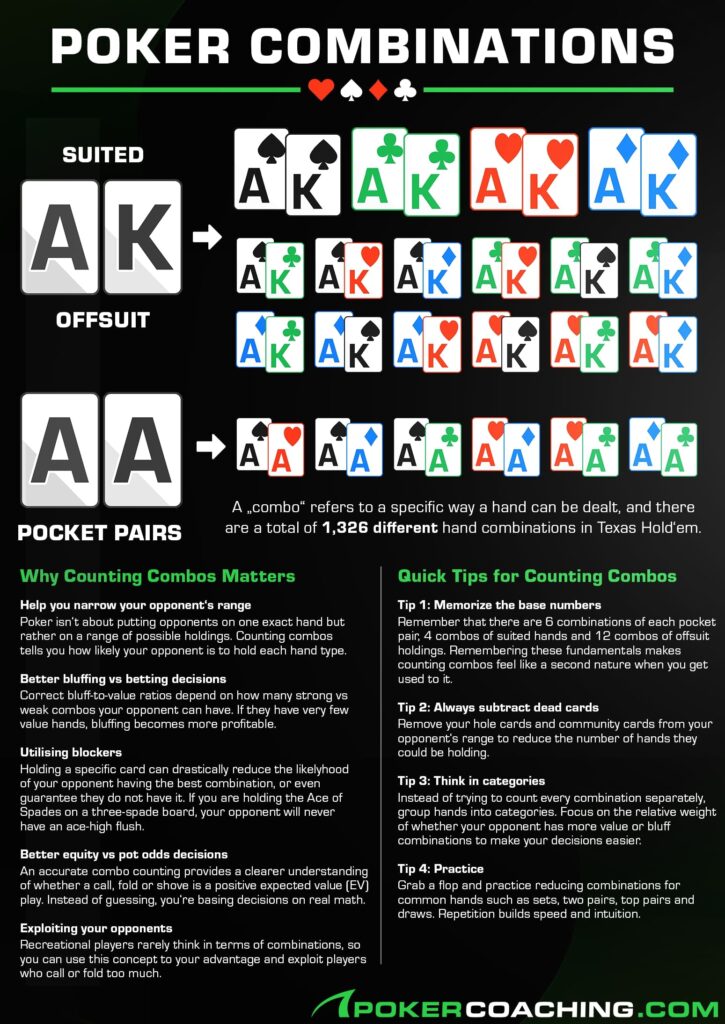Poker is a complex game with many strategies for coming out on top, but they all start with some basic math.
Above all things, understanding how poker combinations work is essential, as this part of poker math, pot odds, and expected value are the underlying principles behind any play you should make at the table.
Whether we are talking about preflop raising ranges or river bluffs, everything is based on a fundamental understanding of poker combinations.
For that reason, this article is aimed at teaching you how to count combinations in poker and how to use them to increase your EV in the long run.
Before we can use poker combinatorics, we must first learn how to count poker combos and what a combo is in poker.

Download Poker Combinations PDF Guide
What Are Poker Combinations
Let’s start with some poker basics. First, poker is played with a standardized deck of 52 cards. There are four suits and 13 card ranks in each deck, making up the 52 cards.
In Texas Hold’em Poker, a total of 1,326 poker combinations can be made up of these 52 cards by combining each of them with all the other ones in the deck.
This includes pocket pairs, suited, and off-suit combinations of all the possible hands.
For a visual representation of poker combinations, you can take a look at the poker hand grid, which includes every possible hand combination.

You will notice that the hand grid is not split up into 1,326 fields, and this is for a good reason. Each field on the hand grid contains multiple hand combos!
In particular, hand combinations are counted as follows:
- There are 6 combinations of every pocket pair
- There are 4 combinations of every suited hand
- There are 12 combinations of every off-suit hand
Off-suit hands have the most poker combinations because every card can be combined with three cards of suits that don’t match to create an off-suit combo. So, for instance, you can combine four Aces with three Kings each to create the 12 off-suit combinations of AK.
Similarly, each Ace can only be combined with one King to create a suited AK combination, leading to the four total combos of a suited hand.
Finally, there are six combos of every pocket pair. For example, AsAh, AsAd, AsAc, AhAd, AhAc, AdAc, and that’s the maximum number of pair combos you can have in any given spot.
This information may seem somewhat random, but it becomes essential when you start thinking about your opponent’s ranges and determining how likely they are to have different starting hands in the hole.
Using Poker Combinations to Construct Ranges
Now that you know what poker combinations are and how to count them, the real question is how you can use those to your advantage in-game.
To answer that question, we must first talk about how you should think about your opponent’s hands and your perceived hand in every situation.
Long gone are the days when we would try to guess our opponent’s hand and our opponent would try to guess ours, only to both end up being wrong at the showdown.
Instead, the game is now played on the level of poker ranges, where all skilled players are trying to pinpoint the range of hands their opponents could have in a given situation.
For example, a player raising from UTG can easily have AA, KK, QQ, AK, and a number of other hands, and there is really no way to tell one hand from another by that raise alone.
Yet, we can most definitely say (assuming he is a reasonably skilled player) that he does not have a hand like T2, 73, or K5, as he would definitely fold this hand from his position.

With each new action that is made at the table, we can narrow down the hand range of each active player in the hand until we are left with only a few possible hand combinations by the river.
As we enter the later streets, the importance of poker combinations becomes significant, as we can now start counting particular poker hand combinations a player might have.
For instance, we know there are six combinations of AA, twelve combinations of AK, and four combinations of AK.
However, on a board of As9d7s, that number changes. There are now only three remaining combos of AA, nine combos of AK, and three combos of AKs, as the As on the board block out the other combos.
This, of course, is a very basic example of how counting hand combinations can help you throughout a poker hand as you reach the later streets and are able to discount more and more of the hand combos your opponent might have.
By the river, you will often be able to determine which specific card combinations your opponent may be betting for value and which could serve as reasonable bluff candidates to fire with, which can be the great deciding factor between bluff catching a big river bet or throwing your cards in the muck correctly.
Putting Poker Combinations to Use
We have briefly discussed how counting poker combinations can help you make the right decision, but let us put this skill to use in an example and demonstrate exactly how it works in real-game scenarios.
In a $1/3 live game in Las Vegas, you are seated in the big blind, and a player in the Cutoff opens to $10, which you call.
The dealer puts out a flop of Ad5s6s, you check your entire range, and your opponent puts out a bet of $8 into the $21 pot.
At this point, our opponent’s range is still very wide and can include all sorts of hands, as it would make sense for them to continue betting with a big chunk of their opening range, if not the entire opening range.
This includes all pocket pairs, all suited Aces, all suited Broadways, plenty of off-suit Broadways, suited connectors, suited Kings, Queens, and more.
In fact, the opponent should be opening with about 30% of all starting hands, which would amount to over 400 poker combinations, too many to pinpoint at this time.
However, let us imagine you have a hand that’s worth raising on this flop, and you bump it up to $35, to which your opponent responds with a call.
Things have now changed dramatically!
Your opponent can no longer have random suited hands in clubs or hearts and will even give up some suited combos in diamonds, while some players will fold all diamond combos except the ones that also have a straight draw.
You can now start counting actual hand combinations that our opponent can have. Let’s start by counting the hands that have at least top pair or better in this spot:
- AA – 3 combos
- 66 – 3 combos
- 55 – 3 combos
- A6s – 2 combos
- A5s – 2 combos
- 65s – 3 combos
- AKs – A7s – 21 combos
- AKo – A7o – 63 combos
- A4s – A2s – 6 combos
- A4o – A2o – 9 combos
This is a total of 115 poker combinations of top pair or better that our opponent would probably call the flop raise with, considering we can have a number of drawing hands to be raising with.
In addition, our opponent can have a number of flush draws and straight draws himself, with hands like 43s, 87s, and 97s all coming to mind, along with all suited hands in spades like KsQs, KsJs, KsTs, QsJs, QsTs, JsTs, Ts9s, Ts8s, 9s8s, and numerous straight draws in other suits.

As the hand progresses and you get more information on your opponent’s hand, it is possible to decrease the number of poker hand combos in their range, often to just a few dozen total combos.
Thinking about poker hands in terms of hand combinations every time you play will help you get a better understanding of poker and determine what playing style you’re up against and how likely they are to be bluffing in certain spots.
For example, if you notice a player continuing to barrel turns with hands like weak draws or even no-draw type hands, you can use that information to your advantage later and assume they have a lot more combos of bluffs in their range when betting than an average player.
Practice Combo Counting Before Your Next Game
Now that you understand what poker combinations are and how to count them, you can do some practice away from the table and prepare for your next game.
Once you learn how to count poker combinations quickly while playing, you will be able to construct your opponents’ ranges faster and reach better conclusions on what they are likely to have.
Doing these types of exercises at home can help you improve your poker strategy, become a much better poker player over time, and think about poker on a whole other level than most other players in your games.





